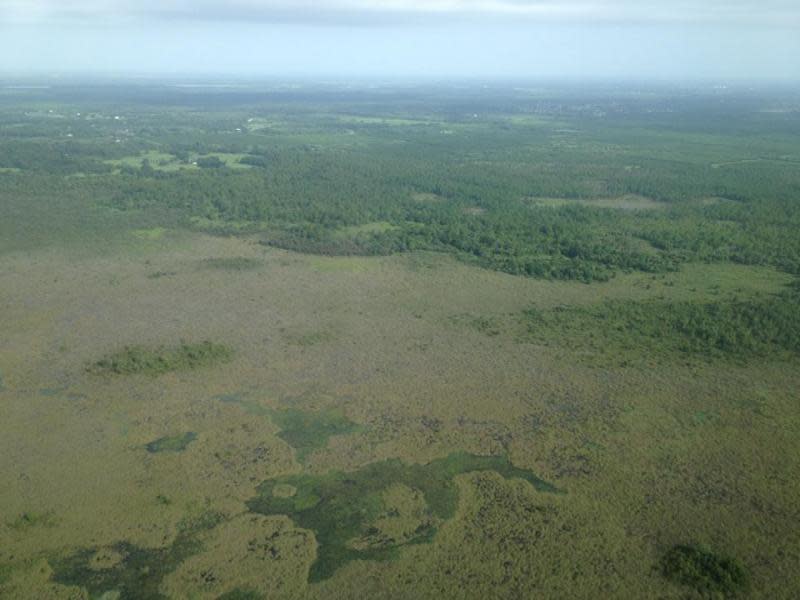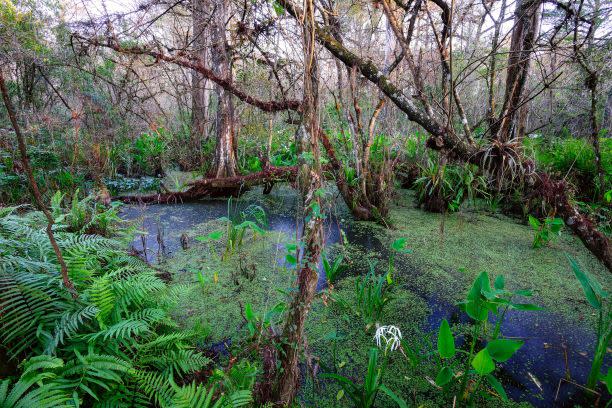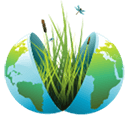
Corkscrew Swamp Sanctuary
About
GENERAL INFORMATION
Criteria:
- Currently a Ramsar Site
- Protects biological diverse wetland flora, fauna and/or their habitat
- Supports significant numbers of wetland-dependent fauna, such as water birds or fish
- Rare or unique wetland type within its own biogeographical region. (Meeting this criteria would include, but is not limited to, wetlands with unique hydrology or chemistry that make it rare within its own region)
Located in southwest Florida, Corkscrew Swamp Sanctuary is a unique remnant of the Western Everglades. Corkscrew is comprised of pine flatwoods, wet prairies, cypress swamps, and marshes. The majestic 600-year-old bald cypress trees reach heights of 40 m and comprise the largest remaining virgin bald cypress forest in the world. The endangered wood stork (Mycteria americana) nests high in these trees. In addition, nearly 200 species of birds including the critically endangered (IUCN) Florida Bonneted Bat (Eumops floridanus) and 22 species of threatened or endangered orchids live on the site. Part of the site, formerly used as a mitigation bank, covers created/restored marshes, and the area serves as a vital link between several south Florida watersheds. Currently, the site is used for conservation and in limited areas, scientific research and tourism. The site is owned and managed by National Audubon Society.
Exemplary Ecosystem Services:
Maintains ecological connectivity/cohesion
Aesthetic/cultural heritage value/ provisioning
Recreation (birdwatching, ecotourism)
Aquifer recharge
Storm abatement
Flood storage/mitigation
Carbon storage
Water quality improvement
Education
CONSERVATION STATUS AND THREATS
Conservation status: RAMSAR Designation
Adjacent Land Use: Agricultural (cropland, orchards, greenhouse)
Approximate natural buffer width: < 5 ft
Other information:
The ecological integrity of this wetland faces a growing host of threats:
Invasive plants present an ongoing land management challenge and require full-time staff to remove them using mechanical, chemical, and biocontrol methods.
Fire suppression throughout the region coupled with encroaching development has made efforts to maintain a natural fire regime, through prescribed fire, increasingly challenging.
Staff have documented a significant loss of ground water in recent decades decreasing hydroperiod across the sanctuary. This water loss threatens to change plant communities, change understory dry season microclimate, and leave the old-growth bald cypress vulnerable to devastating wildfires. Water loss and fire suppression also lead to succession from herbaceous to woody plant species, increasing water loss via evapotranspiration.
Invasive fauna also present a threat to the ecosystem. Native fish communities have been replaced by non-native fishes in many areas, particularly on the periphery of the sanctuary and in manmade ditches. Redbay ambrosia beetles and other pests are a significant threat. While not yet present in the sanctuary, Burmese pythons and Argentine Black-and-white Tegus have been found in the immediate area and are expected to eventually move into the sanctuary. Feral hogs are present, often in significant numbers, causing soil disturbance, uprooting vegetation, and encouraging the spread of non-native grasses.
Land use changes throughout the region threaten wildlife, particularly wading birds, foraging throughout the regional landscape, and Florida panthers, who require large areas of home range, safe road crossings, and wildlife corridors.
Is there any other information that should be conveyed regarding your nomination of this wetland? Preview Code Editor: National Audubon Society has 65 years of data and information on this site. Please let us know if any other information or support is needed.
ECOLOGY
Approximate size: 5261
General wetland characterization:
- Inland Fresh Seasonally Flooded Basin/Flat
- Inland Fresh Meadow
- Inland Shallow Fresh Marsh
- Inland Deep Fresh Marsh
- Inland Fresh Shrub Swamp
- Inland Fresh Wooded Swamp
Surficial Geology:
Shelly sediments of Plio-Pleistocene age: Tertiary-Quaternary Fossiliferous Sediments of Southern Florida - Molluskbearing sediments of southern Florida contain some of the most abundant and diverse fossil faunas in the world. Lithologically these sediments are complex, varying from unconsolidated, variably calcareous and fossiliferous quartz sands to well indurated, sandy, fossiliferous limestones (both marine and freshwater). Clayey sands and sandy clays are present. These sediments form part of the surficial aquifer system.
Soils:
Predominently sands with peat accumulations in depressions, with scattered limerock and shell beds beneath the surface (https://corkscrew.audubon.org/sites/g/files/amh511/f/duever_1976.pdf).
Additional information: Custom Soil Resource Report for Collier County Area, Florida, and Lee County, Florida: Corkscrew Swamp Sanctuary Soils
FLORA AND FAUNA
Dominant flora: Botanists have documented 770 species and 773 infrageneric taxa of vascular plants within the sanctuary. Some commonly seen plants include: cypress, slash pine, wax myrtle, cabbage palm, saw palmetto, red maple, goldenrod, swamp lily, bushy bluestem, wiregrass, tickseed, sawgrass, and live oak.
Unique flora: Eighteen taxa at CSS are endemic to Florida, with examples including Aristida patula, Bigelowia nudata subsp. australis, Campanula floridana, Carex vexans, and Carphephorus odoratissimus var. subtropicanus. For the complete list see Wilder and McCollom (2018).
Dominant fauna: Around 200 species of birds inhabit Corkscrew Swamp Sanctuary throughout the year, including anhingas, barred owls, egrets, herons, ibis and limpkins. Other commonly seen animals include alligators, snakes, tree frogs, red-bellied turtles, white-tailed deer, river otters, etc.
Rare fauna: Unique (non-RTE) fauna species found in the sanctuary include Florida Black Bear, North American river otters, gray fox, spotted skunk, Eastern diamondback rattlesnake, coachwhip, and swamp darters.
Images



